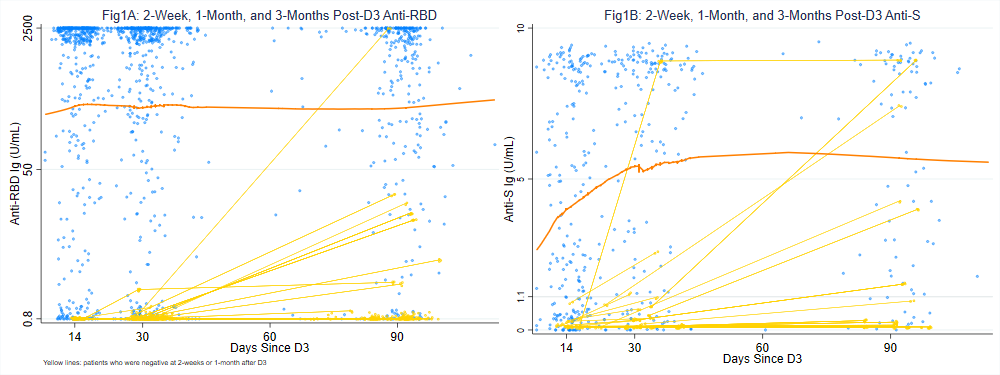Kinetics and Durability of a Third Dose of Sars-cov-2 Vaccination Among Solid Organ Transplant Recipients
T. P. Chiang, J. Alejo, J. Mitchell, A. Abedon, L. Zeizer, J. Kim, L. Thomas, D. Segev, W. Werbel, A. Massie
Johns Hopkins University, Baltimore, MD
Meeting: 2022 American Transplant Congress
Abstract number: 692
Keywords: Antibodies, COVID-19, Vaccination
Topic: Clinical Science » Infection Disease » 24 - All Infections (Excluding Kidney & Viral Hepatitis)
Session Information
Session Name: All Infections (Excluding Kidney & Viral Hepatitis) I
Session Type: Poster Abstract
Date: Saturday, June 4, 2022
Session Time: 5:30pm-7:00pm
 Presentation Time: 5:30pm-7:00pm
Presentation Time: 5:30pm-7:00pm
Location: Hynes Halls C & D
*Purpose: Understanding the dynamics of antibody response to a third dose (D3) of anti-SARS-CoV-2 vaccine in solid organ transplant recipients (SOTRs) is important to inform booster strategies.
*Methods: We studied the the dynamics of anti-RBD (Roche, <0.8 to >2500 U/dL) and anti-S (Euroimmun, 0.1 to >8.9 AU) antibody levels in a cohort of SOTRs at 2 weeks, 1 month and 3 months after D3. We compared the proportion of seroconversion at 1 month or 3 months after D3 between mRNA and Ad.26.COV2.S D3 recipients, using Poisson regression with robust standard error, adjusting for age and numbers of immunosuppressants.
*Results: Among 928 SOTRs with 2-week (n=655), 1-month (n=651) or 3-month (n=404) post-D3 titer, 78%, 82% and 86% tested positive for antibodies. The median (IQR) anti-RBD at the three timepoints were >2500 (73, >2500), 2494 (49, >2500) and 1234 (59, >2500) U/mL (Figure 1A, blue), and there were 61% (n=436), 60% (n=491) and 53% (n=313) with anti-RBD> 1000 u/mL, respectively. The median (IQR) anti-S at the three timepoints were 3.2 (0.3, 8.4), 8 (2, >8.9) and 7.4 (2, >8.9) AU (Figure 1B, blue), and there were 47% (n=218), 61% (n=161) and 64% (n=91) who developed anti-S>4 AU. Among patients with no or minimal immune response at 2 weeks post-D3 (n=102), 3/41 (7%) had increased anti-RBD by 1 month while 11/18 (61%) had increased anti-S (Fisher exact p<0.001). 6/29 (21%) had increased anti-RBD by 3 months while 12/20 (60%) had increased anti-S (p<0.01) (Figure 1A&B, yellow). 27/102 (27%) of them seroconverted at 1 or 3 months after D3. Having received Ad.26.COV2.S as D3 is associated with 3.9X increased proportion of seroconversion at 1 month or 3 months among patients with no or minimal immune response at 2 weeks after D3 (aIRR=2.223.926.92, p<0.001).
*Conclusions: Among SOTRs who received a booster anti-SARS-CoV-2 vaccination, dynamics of Anti-RBD and Anti-S antibodies differed substantially. Anti-RBD titers on average declined only slightly after 14 days post-D3, while anti-S increased up through 30-60 days post-D3. After the peak, average titer values for both antibodies declined slightly through three months post-D3.
To cite this abstract in AMA style:
Chiang TP, Alejo J, Mitchell J, Abedon A, Zeizer L, Kim J, Thomas L, Segev D, Werbel W, Massie A. Kinetics and Durability of a Third Dose of Sars-cov-2 Vaccination Among Solid Organ Transplant Recipients [abstract]. Am J Transplant. 2022; 22 (suppl 3). https://atcmeetingabstracts.com/abstract/kinetics-and-durability-of-a-third-dose-of-sars-cov-2-vaccination-among-solid-organ-transplant-recipients/. Accessed December 28, 2025.« Back to 2022 American Transplant Congress

